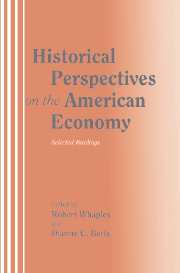Book contents
- Frontmatter
- Contents
- Acknowledgments
- Introduction to students
- Introduction to instructors
- Contributors
- I Introduction
- II Colonial and early national economy
- III Slavery and servitude
- IV The South since the Civil War
- V The rise of American industrial might
- VI Populism
- VII Women in the economy
- 17 “The changing economic role of women: A quantitative approach”
- VIII The Great Depression
- Appendix: Basics of regression
- Glossary
- Name index
- Subject index
17 - “The changing economic role of women: A quantitative approach”
Published online by Cambridge University Press: 05 June 2012
- Frontmatter
- Contents
- Acknowledgments
- Introduction to students
- Introduction to instructors
- Contributors
- I Introduction
- II Colonial and early national economy
- III Slavery and servitude
- IV The South since the Civil War
- V The rise of American industrial might
- VI Populism
- VII Women in the economy
- 17 “The changing economic role of women: A quantitative approach”
- VIII The Great Depression
- Appendix: Basics of regression
- Glossary
- Name index
- Subject index
Summary
In the early nineteenth century only a small fraction of women in the United States worked in the agricultural, industrial, and service components of the market sector. Within agriculture the wages of females relative to those of men were exceptionally low. But, wherever industry spread, relative wages for females increased, and their employment appeared linked to the diffusion of the factory system. The female labor force that expanded in the nineteenth century was primarily young and unmarried. It was not until the twentieth century that married women entered the market sector in any substantial way, first in the 1920s when young, and later, in the 1940s and 1950s, in their post-child-rearing years. Impressive gains in the participation of married women in the labor force were eventually achieved, with particular age groups affected during particular decades. This article explains the timing and the form of this expansion in the market role of married, white women in the United States.
The focus is on those who are married because of their numerical importance among all women, and because changes in their economic role have had repercussions transcending the economic sphere. Single women are not, however, ignored. The labor force, education, and home experiences of young, single women have profoundly influenced their economic roles when married and have also affected the economic roles of their mothers. My methodology stresses a life-cycle approach to understanding change in the economic role of married women.
- Type
- Chapter
- Information
- Historical Perspectives on the American EconomySelected Readings, pp. 549 - 572Publisher: Cambridge University PressPrint publication year: 1995
- 1
- Cited by



